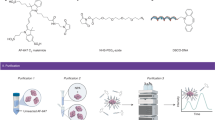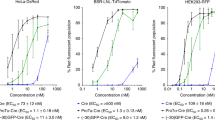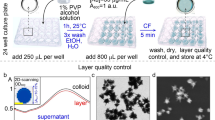Abstract
We have developed a novel gene delivery scaffold based on DNA plasmid condensation with colloidal gold/polyethylenimine conjugates. This scaffold system was designed to enable systematic study of the relationships between DNA complex physical properties and transfection efficiency. Using an enhanced green fluorescent protein-coding reporter plasmid and a Chinese hamster ovary cell line, we have measured the transfection efficiencies of our complexes using flow cytometry and their cytotoxicities using the trypan blue assay. We have also assayed complex particle morphologies using atomic force microscopy, photon correlation spectroscopy, and a novel plasmon absorbance peak position analysis. We achieved comparable rates of transfection relative to the commonly used polycationic condensation agents calcium phosphate and LipofectAMINE™, with comparably low cytotoxicities. In addition, by manipulating colloidal gold concentration, we could partially decouple complex physical properties including charge ratio, size, DNA loading, and polyethylenimine concentration. Our morphological analyses showed that complexes with a diameter of a few hundred nanometers and a charge ratio of ∼8 perform best in our transfection efficiency assays. The use of colloidal gold as a component in our delivery system provides a versatile system for manipulating complex properties and morphology as well as a convenient scaffold for planned ligand conjugation studies.
This is a preview of subscription content, access via your institution
Access options
Subscribe to this journal
Receive 12 print issues and online access
$259.00 per year
only $21.58 per issue
Buy this article
- Purchase on Springer Link
- Instant access to full article PDF
Prices may be subject to local taxes which are calculated during checkout








Similar content being viewed by others
References
Gonzalez H, Hwang SJ, Davis ME . New class of polymers for the delivery of macromolecular therapeutics. Bioconjugate Chem 1999; 10: 1068–1074.
Boussif O et al. A versatile vector for gene and oligonucleotide transfer into cells in culture and in vivo: polyethylenimine. Proc Natl Acad Sci USA 1995; 92: 7297–7301.
Ruponen M, Yla-Herttuala S, Urtti A . Interactions of polymeric and liposomal gene delivery systems with extracellular glycosaminoglycans: physicochemical and transfection studies. Biochim Biophys Acta 1999; 1415: 331–341.
Boulikas T, Martin F . Histones, protamine, and polylysine but not poly(E:K) enhance transfection efficiency. Int J Oncol 1997; 10: 317–322.
Zanta M-A, Boussif O, Adib A, Behr J-P . In vitro gene delivery to hepatocytes with galactosylated polyethylenimine. Bioconjugate Chem. 1997; 8: 839–844.
Ogris M et al. The size of DNA/transferrin–PEI complexes is an important factor for gene expression in cultured cells. Gene Therapy 1998; 5: 1425–1433.
Goula D et al. Polyethylenimine-based intravenous delivery of transgenes to mouse lung. Gene Therapy 1998; 5: 1291–1295.
Bettinger T, Remy J-S, Erbacher P . Size reduction of galactosylated PEI/DNA complexes improves lectin-mediated gene transfer into hepatocytes. Bioconjugate Chem 1999; 10: 558–561.
Bischof J, Vietor I, Cotten M, Huber LA . Transient transfection of mammary epithelial cells with a PEI/DNA/adenovirus system. Biol Chem 1999; 380: 269–273.
Handley DA . Introduction. In: Hayat MA (ed). Colloidal Gold: Principles, Methods, and Applications, Vol. 1. Academic Press, Inc.: London, 1989, pp 14–32.
Frens G . Controlled nucleation for the regulation of the particle size in monodisperse gold solutions. Nat Phys Sci 1973; 241: 20–22.
Templeton AC, Chen S, Gross SM, Murray RW . Water-soluble, isolable gold clusters protected by tiopronin and coenzyme A monolayers. Langmuir 1999; 15: 66–76.
Brust M et al. Synthesis of thiol derivatised gold nanoparticles in a two-phase liquid–liquid system. J Am Chem Soc Chem Commun 1994: 801–802.
Goodman SL, Hodges GM, Trejdosiewicz LK, Livingston DC . Colloidal gold markers and probes for routine application in microscopy. J Microsc 1981; 123: 201–213.
Handley DA, Chien S . Colloidal gold: a pluripotent receptor probe. Proc Soc Exp Biol Med 1983; 174: 1–11.
Weisbecker CS, Merritt MV, Whitesides, GM . Molecular self-assembly of aliphatic thiols on gold colloids. Langmuir 1996; 12: 3763–3772.
Bain CD et al. Formation of monolayer films by the spontaneous assembly of organic thiols from solution onto gold. J Am Chem Soc 1989; 111: 321–335.
Barreleiro PCA, Olofsson G, Alexandridis P . Interaction of DNA with cationic vesicles: a calorimetric study. J Phys Chem B 2000; 104: 7795–7802.
Dunlap DD, Maggi A, Soria MR, Monaco L . Nanoscopic structure of DNA condensed for gene delivery. Nucleic Acids Res 1997; 25: 3095–3101.
Chen C, Okayama H . High-efficiency transformation of mammalian cells by plasmid DNA. Mol Cell Biol 1987; 7: 2745–2752.
Godbey WT, Wu KK, Mikos AG . Poly(ethylenimine)-mediated gene delivery affects endothelial cell function and viability. Biomaterials 2001; 22: 471–480.
Grabar KC, Freeman RG, Hommer MB, Natan MJ . Preparation and characterization of Au colloid monolayers. Anal Chem 1995; 67: 735–743.
Chan CK, Senden T, Jans DA . Supramolecular structure and nuclear targeting efficiency determine the enhancement of transfection by modified polylysines. Gene Therapy 2000; 7: 1690–1697.
Ausubel FM (ed). Current Protocols in Molecular Biology Vol. 1. Greene Pub. Associates: New York, 1988.
Acknowledgements
Partial support of this work was provided by the Department of Chemical Engineering at Carnegie Mellon University, a Clare Boothe Luce Fellowship to MS, and an ICI Summer Research Fellowship to JG. We also express our appreciation to Greg Fisher and Christoffer Lagerholm in the Center for Light Microscope Imaging and Biotechnology for his help with fluorescence microscopy and flow cytometry; to Carrie Doonan, Adam Linstedt, and Amy Mehta in the Department of Biology for their assistance with cell culturing; and to Ijeoma Nnebe in the Department of Chemical Engineering for her help with AFM.
Author information
Authors and Affiliations
Rights and permissions
About this article
Cite this article
Ow Sullivan, M., Green, J. & Przybycien, T. Development of a novel gene delivery scaffold utilizing colloidal gold–polyethylenimine conjugates for DNA condensation. Gene Ther 10, 1882–1890 (2003). https://doi.org/10.1038/sj.gt.3302083
Received:
Accepted:
Published:
Issue Date:
DOI: https://doi.org/10.1038/sj.gt.3302083
Keywords
This article is cited by
-
Parallel multi-parameter study of PEI-functionalized gold nanoparticle synthesis for bio-medical applications: part 1—a critical assessment of methodology, properties, and stability
Journal of Nanoparticle Research (2019)
-
Scaffold-mediated delivery for non-viral mRNA vaccines
Gene Therapy (2018)
-
An efficient, non-viral dendritic vector for gene delivery in tissue engineering
Gene Therapy (2017)
-
Biomedical applications and safety issues of gold nanoparticles
Toxicology and Environmental Health Sciences (2012)
-
Enhanced immunostimulatory properties in CpG-oligonucleotides modified by gold nanoparticles
Journal of Wuhan University of Technology-Mater. Sci. Ed. (2011)



